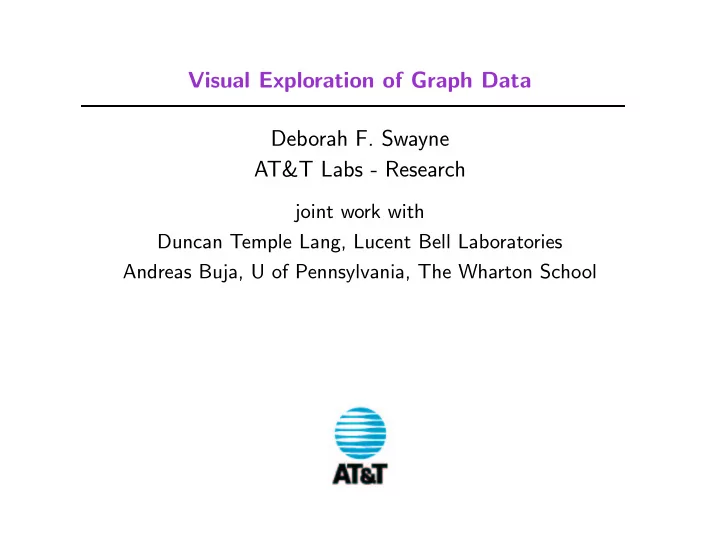

Visual Exploration of Graph Data Deborah F. Swayne AT&T Labs - Research joint work with Duncan Temple Lang, Lucent Bell Laboratories Andreas Buja, U of Pennsylvania, The Wharton School
Outline • Elements of exploratory visualization of graphs • Introductory demos • The software environment • Final demos
What’s different about graphs? • Three interconnected data structures (approximately) – data associated with nodes – data associated with edges – the graph itself • Different communities specialize in different data structures – graph drawing community: graph layout – statisticians: multivariate data analysis, visualization – social network analysts: a bit of both
Goal: an integrated environment Integration of • data format that encompasses graphs and multivariate data • scripting language to construct and manipulate graphs • graph layout algorithms to generate spatial mappings • other graph algorithms: searches, finding cliques, cycles, ... • high-quality static graphics • direct manipulation visualization – tweaking, pruning, navigating the graph – linking a variety of displays
Demos: simple graphs • a corporate intranet • the permutation graph of degree 3
Discussion of first examples What we saw • R: generated graph description • Rggobi (an R package): initiated ggobi • ggobi: laid out the graph, tuned the layout, explored the graph
Graphs with data • multivariate data for each node – telephone number: usage characteristics, household demographics, ... – person: gender, age, ... – country: population, type of government, ... • multivariate data for each edge – frequency, duration, type of contact ...
Demo: a graph with data • a COI with its variables and labels masked
Software integration: the components • R: language and environment for statistics • ggobi: general-purpose multivariate data visualization • Rggobi: R package for driving ggobi • extensions to ggobi (plugins) for graphs
Visualization: ggobi • General visualization methods – linked views – ease of manipulation: painting, scaling, rotation, ... – data operations: subsetting, variable transformation, ... – high-dimensional projections • Visualization methods of particular interest for graphs – edge painting and identification – point motion – edge editing: adding nodes and edges
Layout and navigation: plugins to ggobi • layout methods – radial layout – neato and dot (www.graphviz.org) – ggvis: multidimensional scaling • pruning methods, navigation
Data formats: handing the graph to ggobi • ggobi alone: XML – nodes <record id="Banquo"> 2.4 7.7 </record> <record id="Macbeth"> 1.0 2.5 </record> – edges <record source="Macbeth" destination="Banquo"> 66.3 -4 .78 </record> • ggobi embedded: R data structures
Programming environment: ggobi in R • ggobi can be embedded in R, and driven through its API • Rggobi functionality includes: – construct a graph in R, hand it to ggobi – read results from ggobi displays back into R – respond to ggobi events Aside: ggobi can of course be run independently of R, and then graphs are specified in XML.
Further work • R packages of graph algorithms are emerging, presenting opportunities for further integration • other graph manipulations: aggregation, working with subsets • other scripting languages: python Where to get it: www.ggobi.org Paper corresponding to this talk: www.ci.tuwien.ac.at/Conferences/DSC-2003 Does it work under Windows? Yes, but getting all the plugins to work is a bit tricky.
Recommend
More recommend